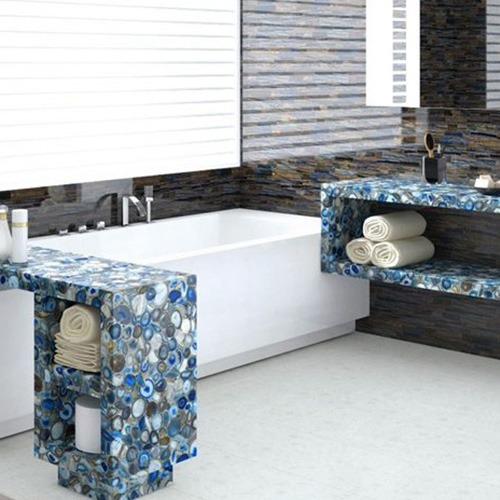BLUE AGATE FOR YOUR SPACE
Blue Agate is a hard stone that belongs to the agate family of gemstones and ranks high on the Mohr scale. Its light blue colour gives it wonderfully soft, relaxing qualities reminiscent of pure sky-blue lakes while being highly durable.The symbolism and healing powers of blue lace agate crystals are numerous.
What is blue Agate? Blue Agate slab, like all other members of the agate family, is a banded Chalcedony variation and a quartz mineral. The diamond has bands of blue layers, the majority of which range from extremely light to vivid, nearly sapphire blue in colour. Occasionally, brown threads can be found in these stones. Agate stones are often known as "earth rainbows." Nature's colourful bands developed practically every colour the earth can provide in its different forms.
How To Use Blue Lace Agate?
- Agate with blue lace can also be used in a variety of ways.
- It can be shown in a sitting room or part of the house to help people communicate more effectively. If you have to talk or perform in front of an audience, you can keep it in your pocket.
- Adorning blue lace crystal in or as a pendant around the throat chakra or as close to it as possible is helpful as it helps way to use it. This will aid in ensuring that the crystal works in accordance with the chakra
- Overall, lace agate is a fantastic addition to any blue gem collection. It's lovely and uncommon, which adds to its value.
- Given its wonderful blue colours, it looks lovely set in accessories and gives a lovely flair to practically any autumn attire. The stone, on the other hand, has a lot of power of its own that is useful to the bearer on several levels. It's not simply beautiful to look at; it's also powerful!
Agate is a banded quartz stone that belongs to the chalcedony quartz family. He belongs to the oxide mineral class. It's made up of consecutively accumulated quartz layers in rock crevices that can still be found. Different quartz varieties and foreign particles such as iron, chromium, and manganese compose the separate layers. As a result, the many colours and patterns of Agate emerge, eventually becoming the various variations.
Agate can be used in a variety of ways. You should wear that as much as possible as a protection stone, especially as an agate bracelet, necklace, or scarab. Direct skin contact, on the other hand, is critical if it is meant to have a particular effect on an organ or a bodily site. Hold it as close to the damaged organ as possible or directly on the body place.
This fortunate and protecting stone helps guard against negative influences and even sadness. Blue agate, worn as jewellery in the flat, will be capable of keeping any evil at bay. At the same time, he can increase his willpower and make his interactions with others more sensitive.
The agate can represent a thousand-year-old admiration. Agate was used to make jewellery and vessels in Ancient Egypt. There is no reliable information about how the name came to be. The first finding of an agate from the Achates River (now Dirillo) is thought to have occurred in southwestern Sicily.
Its value as a gem and ability to heal stone was recognised early on, and segments of the patterned stone were worn as fortunate charms by both Greeks and Egyptians. It was once thought that the agate could make its wearer invisible and therefore shield them from lightning and thunder.





